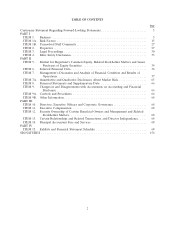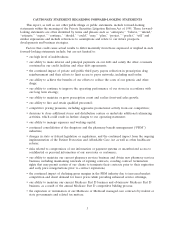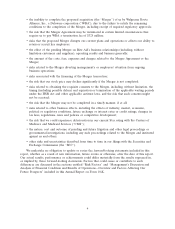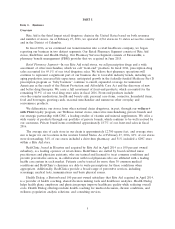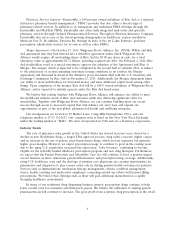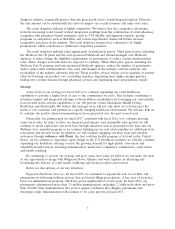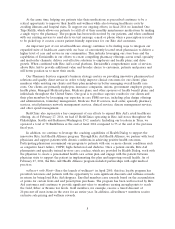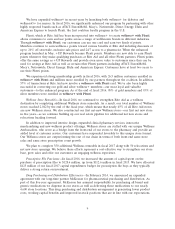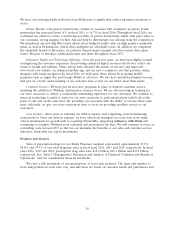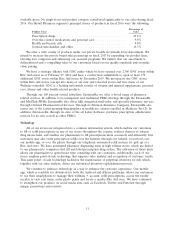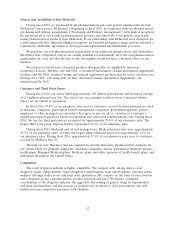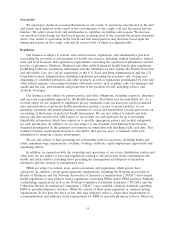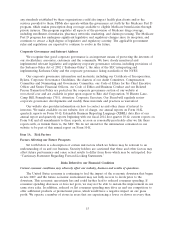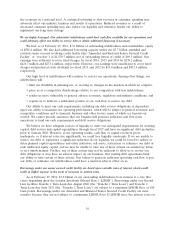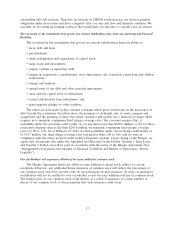Rite Aid 2016 Annual Report Download - page 7
Download and view the complete annual report
Please find page 7 of the 2016 Rite Aid annual report below. You can navigate through the pages in the report by either clicking on the pages listed below, or by using the keyword search tool below to find specific information within the annual report.drugstore industry is generally greater than the gross profit from a brand drug prescription. However,
the sale amount can be substantially less and can impact our overall revenues and same store sales.
The retail drugstore industry is highly competitive. We believe that the competitive advantages
from the increasing trend toward vertical integration resulting from the combination of retail pharmacy
companies with pharmacy benefit managers, such as CVS Health, and aggressive generic pricing
programs at competitors such as Wal-Mart and various supermarket chains will further increase
competitive pressures in the industry. The retail drugstore business has continued to be highly
promotional, which contributes to additional competitive pressures.
The retail drugstore industry relies significantly on third party payors. Third party payors, including
the Medicare Part D plans and the state-sponsored Medicaid and related managed care Medicaid
agencies, at times change the eligibility requirements of participants or reduce certain reimbursement
rates. These changes and reductions are expected to continue. When third party payors, including the
Medicare Part D program and state-sponsored Medicaid agencies, reduce the number of participants
and/or reduce their reimbursement rates, sales and margins in the industry could be reduced, and
profitability of the industry adversely affected. These possible adverse effects can be partially or entirely
offset by lowering our product cost, controlling expenses, dispensing more higher margin generics,
finding new revenue streams through pharmacy services and dispensing more prescriptions overall.
Strategy
A key focus of our strategy for fiscal 2017 is to continue expanding our retail healthcare
capabilities to provide a higher level of care to the communities we serve. This includes continuing to
introduce unique and integrated offerings to the healthcare marketplace by leveraging our conveniently
located retail stores and the capabilities of our 100 percent owned subsidiaries Health Dialog,
RediClinic and EnvisionRx. We believe this strategic focus will not only allow us to better meet the
needs of our customers and patients in a rapidly changing healthcare environment, but will also help us
to continue the positive financial momentum we have generated over the past several years.
Financially, our primary goal for fiscal 2017, consistent with fiscal 2016, is to continue growing
same stores sales. In order to drive our financial performance and sustainable sales growth, we will
continue to invest capital into our store base through initiatives such as prescription file buys and our
Wellness store remodel program as we continue building up our real estate pipeline for additional store
relocations and net new stores. In addition, we will continue engaging our most loyal and valuable
customers through wellness+ with Plenti, the first coalition loyalty program of its kind in the United
States. As we continue to experience rapid change in the U.S. healthcare industry, we will also continue
expanding our healthcare offering to meet the growing demand for high quality, convenient and
affordable health services, including immunizations, medication compliance consultations, retail clinics
and health coaching.
By continuing to execute our strategy and grow same store sales, we believe we can make the most
of our opportunity to merge with Walgreens Boots Alliance and work together in advancing and
broadening the delivery of retail health, wellbeing and beauty products and services.
Below are descriptions of our key initiatives:
Expanded Healthcare Services—In fiscal 2016, we continued to expand the role of our Rite Aid
pharmacists in delivering wellness services that go beyond filling prescriptions. A key area of focus has
been our immunizations program, which has grown significantly in recent years. In fiscal 2016, our
pharmacists administered more than 3.9 million immunizations, including 3.2 million flu shots and more
than 760,000 other immunizations that protect against conditions like shingles, pneumonia and
whooping cough. Immunizations will continue to be a key priority in fiscal 2017.
7


